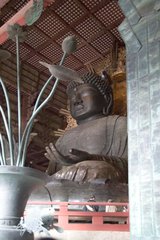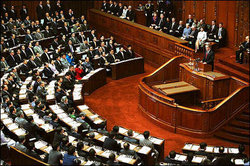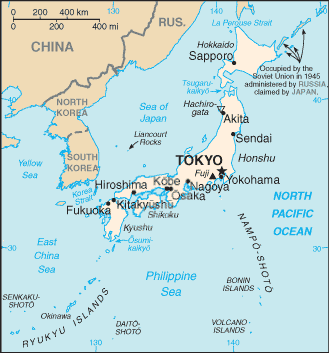Japan
|
|
- For other uses, see Japan (disambiguation).Template:Japan infobox
Japan (日本, Nippon/Nihon, literally "the origin of the sun" or less literally "Land of the Rising Sun" ) is an island country east of the Asian continent on the western edge of the Pacific Ocean. It comprises over 6,800 islands having a coastline 100 meters or longer. The largest and main islands are, from north to south, Hokkaidō (北海道), Honshū (本州, the largest island), Shikoku (四国), and Kyūshū (九州).
| Contents |
History
Main article: History of Japan
Prehistory
Archaeological research indicates that Japan had already been occupied by early humans at least 600,000 years ago, during the Lower Paleolithic period. Over repeated ice ages during the last million years, Japan was regularly connected by land bridges to the Asian mainland (by Sakhalin to the North, and probably Kyushu to the South), facilitating migrations of humans, animals and plants to the Japanese archipelago from the area that is now China and Korea. The Japanese Paleolithic produced the earliest known polished stone tools, around 30,000 BC.
With the end of the Wisconsin glaciation (last ice age) and general warming period, the Jomon culture emerged around 11,000 BC, characterized by a Mesolithic to Neolithic semi-sedentary hunter-gatherer lifestyle and the manufacture of the earliest known pottery in the world. It is thought that Jomon populations were the ancestors of the Proto-Japanese and today's Ainu.
The start of the Yayoi period around 300 BC marked the influx of new technologies such as rice farming, irrigation and iron and bronze-making, brought by migrants from Korea, China and other parts of Asia.
That period was succeeded around AD 250 by the Kofun period, characterized by the establishment of strong military states. In 538, the introduction of Buddhism marks the beginning of the Classical Era.
Classical era
According to traditional Japanese mythology, Japan was founded in the 7th century BC by the ancestral Emperor Jinmu, who started a line of emperors that remains unbroken to this day. Nonetheless, for most of its history, real power was in the hands of the court nobility, the shoguns, the military, or, recently, prime ministers.
Recorded Japanese history began in the 5th and 6th centuries AD, when the Chinese writing system, Buddhism, and other Chinese culture was introduced by Baekje, a kingdom in Korea. Through the Taika Reform Edicts of 645, Japanese intensified the adoption of Chinese cultural practices, and reorganized government in accordance with the Chinese administrative structure. This paved the way for the dominance of Chinese Confucian philosophy in Japan until the 19th century.
The Nara period of the 8th century marked the first strong Japanese state centered around an imperial court in the city of Heijo-kyo (now Nara). The imperial court later moved to Nagaoka and later Heian-kyo (now Kyoto), starting a "golden age" of classical Japanese culture called the Heian period.
Medieval era
Japan's medieval era was characterized by the emergence of a ruling class of warriors called samurai. In the year 1185, general Minamoto Yoritomo was the first to break the tradition of ruling alongside the Emperor in Kyoto, holding power in Kamakura, just south of present-day Yokohama. After Yoritomo's death, another warrior clan, the Hojo, came to rule as regents for the shoguns. The shogunate managed to repel a Mongol invasion from Mongol-occupied China in 1274 and 1281. While this Kamakura shogunate was somewhat stable, Japan soon fell into warring factions and suffered through what became known as the Warring States or Sengoku period.
NanbanGroup.JPG
During the 16th century, traders and missionaries from Europe reached Japan for the first time, initiating the "Nanban" ("Southern barbarian") period of active commercial and cultural exchange between Japan and the West. Around the same time, Oda Nobunaga, Toyotomi Hideyoshi, and Tokugawa Ieyasu, established increasingly strong control over the warring states of Japan. Nobunaga's barbaric and authoritarian handling of the country made him an unpopular warlord, though his military genius was not to be ignored. Hideyoshi's disastrous invasion of Korea in 1592 also gave him a bad name in Japanese History, especially after the Japanese were repulsed by the Ming Dynasty Chinese forces and Korean naval forces.
Tokugawa finally reunified the country by defeating his enemies at the Battle of Sekigahara in 1600, moving the capital to Edo (now Tokyo) and starting the Tokugawa shogunate.
The Tokugawa shogunate, suspicious of the influence of Catholic missionaries, barred all relations with Europeans except for severely restricted contacts with Dutch merchants at the artificial island of Dejima. They also became more conscious of trade with China, especially after the Manchus conquered China and established the Manchu Qing Dynasty. The Manchus conquered Korea in 1637, and the Japanese were scared of a Manchu invasion. Thus, the country became more isolated than ever before. This period of isolation lasted for two and a half centuries, a time of tenuous political unity known as the Edo period, considered to be the height of Japan's medieval culture.
Modern era
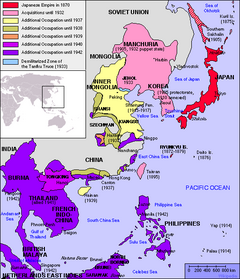
In 1854, U.S. Commodore Matthew Perry forced the opening of Japan to the West with the Convention of Kanagawa. The perceived weakness of the shogunate led many samurai to revolt, leading to the Boshin War of 1867-8. Subsequently the shogunate resigned and the Meiji Restoration returned the Emperor to power. Japan adopted numerous Western institutions in the Meiji period, including a modern government, legal system, and military. These reforms transformed the Empire of Japan into a world power which defeated China in the Sino-Japanese War and Russia in the Russo-Japanese War. By 1910, Japan controlled Taiwan, half of Sakhalin, and Korea.
The early 20th century saw a brief period of "Taisho democracy" overshadowed by the rise of Japanese expansionism. In 1936, Japan signed the Anti-Comintern Pact and joined with Germany and Italy to form the axis alliance. In 1937, Japan invaded Manchuria which led to the the second Sino-Japanese War (1937). In 1941, Japan attacked the United States naval base in Pearl Harbor, bringing America into World War II. After a long campaign in the Pacific Ocean, Japan lost its initial territorial gains, and the United States moved into range to begin strategic bombing of Tokyo, Osaka and other major cities as well as atomic bombing at Hiroshima and Nagasaki. Japan eventually agreed to an unconditional surrender to the Allies on August 15, 1945 (V-J Day).
Official American occupation lasted until 1952, although U.S. forces still retain important bases in Japan, especially in Okinawa. Japan adopted a new constitution, establishing the country as a pacifist democratic nation, in 1947 under the occupation authority. After occupation, under a program of aggressive industrial development, protectionism, and deferral of strategic defense to the United States, Japan's gross national product rose to build one of the largest economies in the world. Despite a major stock market crash in 1990, from which the country has not fully recovered, Japan remains a global economic power and has recently begun to re-emerge as a strategic power, lending non-combat support to the Gulf War, the UN efforts to rebuild Cambodia, and the 2003 invasion of Iraq.
Government and politics
Main article: Politics of Japan
The Diet
Japan is generally considered to be a constitutional monarchy, based largely on the British system. The "highest organ of state power" is its bicameral parliament, the Kokkai or "Diet" (国会). The Diet consists of a House of Representatives (Lower House or Shūgi-in) containing 480 seats, elected by popular vote every four years or when dissolved, and a House of Councillors (Upper House or Sangi-in) of 247 seats, whose popularly elected members serve six-year terms. There is universal adult (over 20 years old) suffrage with a secret ballot for all elective offices.
The Cabinet is composed of a Prime Minister and ministers of state, and is responsible to the Diet. The Prime Minister must be a member of the Diet and is designated by his colleagues. The Prime Minister has the power to appoint and remove ministers, a majority of whom must be Diet members. The conservative Liberal Democratic Party (LDP) has been in power since 1955, except for a short-lived coalition government formed from its opposition parties in 1993; the largest opposition party is the liberal-socialist Democratic Party of Japan.
The Imperial Household
JapanTokyoNijubashi.jpg
Japan's head of state is the Emperor, but under the current constitution he performs only ceremonial duties and holds no real power, not even emergency reserve powers. Sovereignty, previously embodied in the Emperor, is vested in the Japanese people by the Constitution, and the Emperor is defined as the symbol of the State and of national unity. The Imperial Household Agency (Kunaicho) is responsible for the daily running of the palace.
Akihito (明仁) is the current and 125th Emperor of Japan. He assumed the throne after the death of his father, Hirohito, on January 7 1989, formally becoming the 125th Japanese monarch on November 12 1990. His son, Crown Prince Naruhito, married a commoner, Masako Owada, and the couple gave birth to a girl, Princess Aiko. The Imperial Household Law of 1947 limits succession to males: since neither of the former Emperor Hirohito's sons have a direct male descendant, some public and parliament members perceive Chrysanthemum Throne continuity to be in jeopardy despite a line of succession seven levels deep. This perception and a new regard for women's rights led some to call for revision of imperial law to allow succession through females. Speculation in the press has linked deterioration of Crown Princess Masako's health to pressure from Imperial Household bureaucrats to bear a male child.
Geography of Japan
Main article: Geography of Japan
Japan, a country of islands, extends along the eastern or Pacific coast of Asia. The main islands (sometimes referred to as the Home Islands), running from north to south, are Hokkaido, Honshu (or the mainland), Shikoku, and Kyushu. Naha on Okinawa in the Ryukyu archipelago is over 600 km to the southwest of Kyushu. In addition, about 3,000 smaller islands may be counted in the full extent of the archipelago that comprises greater Japan.
- Area: 377,835 sq km (including 3,091 km² of territorial water)
- Major Islands: Honshu, Hokkaido, Kyushu, Shikoku
- Coastline: 29,751 km
- Reclaimed land area in Tokyo Bay : 249 km²
- Highest Peak: Mount Fuji: (3776m/12,385ft)
- Lowest Elevation: Hachiro-gata -4 m
Japan is the 16th most densely populated country in the world (see List of countries by population density). However about 73% of the country is mountainous and unsuitable for agricultural, industrial or residential use due to the generally steep elevations, climate and risk of landslides due to earthquakes and heavy rain. This has resulted in an extremely high population density in the habitable zones, mainly in the coastal areas.
Japan is situated in a volcanic zone on the Pacific Ring of Fire. Frequent low intensity earth tremors and occasional volcanic activity are felt throughout the islands. Destructive earthquakes, often resulting in tsunamis, occur several times a century. The most recent major quakes include the 2004 Chuetsu Earthquake and the Great Hanshin Earthquake of 1995. Hot springs are numerous and have been developed as resorts.
Climate
Japan is a temperate region with, more or less, four seasons (some believe the rainy season should be a fifth season), but because of its great length from north to south, its climate varies from region to region: the far north is very cold in the winter, while the far south is subtropical. The climate is also affected by the seasonal winds blown from the continent to the ocean in winters and vice versa in summers. The waters of the Kuroshio Current also warm the Pacific side of Japan, sustaining the coral reefs of Japan, the northernmost coral reefs in the world. Unfortunately, due to pollution, these reefs are now dying.
Late June and early July are a rainy season (except in Hokkaido), as a seasonal rain front or baiu zensen (梅雨前線) stays above Japan. In the late summer and early autumn, typhoons develop from tropical depressions generated near the equator, and track from the southwest to the northeast, often bringing heavy rain.
Japan's varied geographical features divide it into six principal climatic zones.
- Hokkaido: Hokkaido has a temperate climate with long, cold winters and cool summers. Precipitation is not heavy, but the islands usually develop deep snow banks in the winter.
- Sea of Japan: The northwest wind in the wintertime brings heavy snowfall. In summers, the region is cooler than the Pacific area, but it sometimes experiences extremely hot temperatures due to the Foehn wind phenomenon.
- Central Highlands (Chuo-kochi): A typical inland climate, with large temperature differences between summers and winters and between days and nights. Precipitation is light.
- Seto Inland Sea (Seto-naikai): The Mountains of the Chugoku and Shikoku regions block the seasonal winds, bringing mild weather throughout the year.
- Pacific Ocean: Experiences cold winters with little snowfall and hot, humid summers due to the southeast seasonal wind.
- Nansei-shoto (Ryukyu) or Southwest Islands: Has a subtropical climate with warm winters and hot summers. Precipitation is very heavy, especially during the rainy season. Typhoons are common; in 2004 a record number of 10 typhoons reached the main islands.
Ecoregions
Main Article: Ecoregions of Japan
Japan is home to nine forest Ecoregions, which reflect the climate and geography of the islands. They range from subtropical moist broadleaf forests in the Ryukyu and Bonin islands, to temperate broadleaf and mixed forests in the mild climate regions of the main islands, to temperate coniferous forests in the cold winter portions of northern islands.
Regions
Main article: Regions of Japan
Japan is commonly divided into regions. Japan consists of four main islands and many smaller islands, notably Okinawa. Honshu, by far the largest and most populated island, is typically divided into five (or more) regions. The other islands are not divided into sub-regions in this section, so they will constitute one region each. From north to south, these are
Japan_prefectures.png
Map of Japan
- Hokkaido - major cities are Sapporo and Hakodate.
- Tohoku - northeastern Honshu in which Sendai and Fukushima are large cities.
- Kanto - coastal plain including Tokyo, Kawasaki, Yokohama, and Yokosuka. Also includes Gunma, Saitama, Chiba, Tochigi and Ibaraki Prefectures.
- Chubu - mountainous middle region dominated by the Japan Alps and Japan's fourth-largest city Nagoya.
- Kinki - sometimes called Kansai region, ancient center of culture and commerce, including Osaka, Kyoto, Hyogo, Nara, Wakayama and Shiga. Kinki means near the capital.
- Chugoku - includes the cities Hiroshima and Okayama.
- Shikoku - the smallest of the main four islands, known as a destination for Buddhist pilgrims. The main cities are Matsuyama and Takamatsu.
- Kyushu - southernmost of the four main islands. The main towns include Fukuoka, Kitakyushu and Nagasaki
- Okinawa - semitropical southern island chain reaching out to Taiwan. The only major city is Naha.
Prefectures
Main article: prefectures of Japan
The Local Government Law of Japan divides the country into 47 prefectures, which carry out administrative duties independently of the central government. From north to south (numbering in ISO 3166-2 order), these are:
Territorial disputes
Japan has outstanding territorial disputes over the southern four islands of the Kuril Islands, administered by Russia, as well as the Liancourt Rocks (Kr. Dokdo, Jp. Takeshima), administered by South Korea. The Senkaku Islands (Chinese Diaoyutai) are claimed by the People's Republic of China and the Republic of China.
Economy
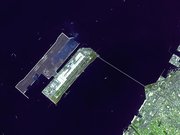
Main article: Economy of Japan
Government-industry cooperation, a strong work ethic, mastery of high technology, emphasis on education and a comparatively small defense allocation (1% of GDP) have helped Japan advance with extraordinary speed to become one of the largest economic powers in the world along with the US and European Union. For three decades overall real economic growth had been spectacular: a 10% average in the 1960s, a 5% average in the 1970s, and a 4% average in the 1980s. Growth slowed markedly in the 1990s largely because of the after effects of overinvestment during the late 1980s and domestic policies intended to wring speculative excesses from the stock and real estate markets. Government efforts to revive economic growth have met with little success and were further hampered in 2000-2001 by the slowing of the US and Asian economies.
Distinguishing characteristics of the Japanese economy include the working together of manufacturers, suppliers, distributors and banks in closely-knit groups called keiretsu; the powerful enterprise unions and shuntō; cozy relations with government bureaucrats, and the guarantee of lifetime employment (shushin koyo) in big corporations and highly unionized blue-collar factories. Recently, Japanese companies have begun to abandon some of these norms in an attempt to increase profitability.
The government of Junichiro Koizumi has enacted or attempted to pass (sometimes with failure) major privatization and foreign-investment laws intended to help stimulate Japan's dormant economy. While some of these laws have been enacted, the economy has yet to respond, and Japan's aging population is expected to place further strain on the economy in the near future.
Agricultural sector
Japan's small agricultural sector is highly subsidized and protected, with government regulations that favor small-scale cultivation instead of large-scale agriculture as practiced in North America. Imported rice, the most protected crop, is subject to tariffs of 490% and restricted to a quota of only 3% of the total rice market. Although Japan is usually self-sufficient in rice (except for its use in making rice crackers and processed foods), the country must import about 50% of its requirements of other grain and fodder crops, and relies on imports for its supply of meat. Japan maintains one of the world's largest fishing fleets and accounts for nearly 15% of the global catch, prompting some claims that Japan's fishing is leading to over depletion in fish stocks such as tuna. Japan has also sparked controversy by supporting quasi-commercial whaling.
Industrial sector
Industry, one-fourth of Japan's GDP, is heavily dependent on imported raw materials and fuels. Internationally, Japan is best known for its automotive and electronics industries, as the home of big manufacturers such as Toyota, Honda, Matsushita, Sony, Nissan, and Toshiba. Japan also holds a large market share in high-technology industries such as semiconductors, industrial chemicals, machine tools, and (in recent years) aerospace. Construction has long been one of Japan's largest industries, with the help of multi-billion-dollar government contracts in the civil sector. Robotics constitutes a key long-term economic strength, with Japan possessing 410,000 of the world's 720,000 "working robots."
Service sector
Japan's service sector accounts for about three-fourths of its total economic output. Banking, insurance, real estate, retailing, transportation, and telecommunications are all major industries. The Koizumi government is attempting to privatize Japan Post, which is also one of the country's largest company for savings and insurance services, by 2007.
See also: List of Japanese companies
Society
Demographics
Main article: Demographics of Japan
Japanese society is ethnically and linguistically homogeneous, with small populations of primarily North and South Koreans (1 million), Okinawan (1.5 million), Chinese and Taiwanese (0.5 million), Filipinos (0.5 million), and Brazilians — mostly of Japanese descent — (250,000), as well as the indigenous Ainu minority in Hokkaido. 99% of the population speaks Japanese as their first language.
Japanese citizenship is conferred on an infant when a family member registers the infant's birth in the family registry held by a neighborhood ward office. Simply being born in Japan does not assure citizenship. Monolingual Japanese-speaking minorities often reside in Japan for generations under permanent residency status without acquiring citizenship in their country of birth. People of Japanese heritage returning to Japan from overseas have citizenship if their birth in a foreign country was registered on their behalf by a family member. Sometimes these returnees are not considered truly Japanese and sometimes suspected of being a descent of old feudal Burakumin "unclean" caste, a group of people known to have immigrated to South American countries, and subject to discrimination.
The Japanese population is rapidly aging, the effect of a post-war baby boom followed by a decrease in births as the country modernized in the latter part of the 20th century (notable aspects including the shift from agricultural to urban lifestyles and the increasing tendency for women to remain in the workplace). Japan now also has the highest life expectancy in the world (85.2 years for women and 78.3 years for men in 2002 [1] (http://unstats.un.org/unsd/demographic/products/dyb/dyb2.htm)). By 2007, when Japan's population growth could stop completely, over 20% of the population will be over the age of 65. The changes in the demographic structure have created a number of social issues, particularly potential decline in workforces and increase in the cost of social securities like the public pension plan. Japanese government planners are currently in a heated debate over how to cope with this problem. [2] (http://www.mofa.go.jp/j_info/japan/socsec/ogawa.html). Immigration and birth incentives are sometimes suggested as a possible solution to provide younger workers to support the graying society. Immigration is not publicly popular as recent increased crime rates are often attributed to foreigners living in Japan.
Religion
Main articles: Religions of Japan and Japanese mythology
The Japanese people's concerns with religion are usually personal and related to mythology, traditions, and neighborhood activities rather than just the source of morality or the guidance for one's life. For one, Confucianism, or even Taoism tends to serve as the basis for the moral code and shakai-tunen (social common idea). When asked to identify their religion, most would profess to believe in either Shintoism (54%) or Buddhism (40%), for simple reasons like their family has belonged to some sect of Buddhism or to avoid contention with religious foreigners. Nonetheless, most of the people are by no means atheists, and the tendency is often identified with syncretism. This results a variety of practices such as parents and children celebrating Shinto rituals, students praying before exams, couples holding a wedding at a Christian church and funerals being held at Buddhist temples. A minority profess to Christianity (0.7%) and other religions (4.7%) like shamanism. Also since the middle of the 19th century many religious sects called Shinkosyukyo and later shinshukyo emerged.
Education
Main article: Education in Japan
Compulsory education was introduced into Japan in 1872 as one result of the Meiji restoration. Since 1947 compulsory education consists of elementary school and middle school, which last for 9 years (from age 6 to age 15). Almost all children continue their education at a three-year senior high school, and 96% of high school graduates attend a university, junior college, trade school, or other post-secondary institution.
Language
Main article: Japanese Language
Before the 4th century the Japanese had no writing system of their own. They began to import and adapt the Chinese writing script along with many other aspects of Chinese culture.
At first, the Japanese wrote in Classical Chinese or in a Japanese-Chinese combination. An example of this style is the Kojiki (古事記), which was written in 712 AD. They then started to use Chinese characters to write Japanese in a style known as manyōgana (万葉仮名), a ten thousand syllabic script which used characters depicting their own values.
Over time, a writing system was constructed. Chinese characters (called "kanji" (漢字)) were used to write either words borrowed from Chinese, or Japanese words with the same or similar meanings. Chinese characters were also used to write grammatical elements and were simplified and eventually became two syllabic scripts; hiragana (ひらがな) and katakana (カタカナ).
Japanese literature reached a high point during the 11th century with the Genji Monogatari (Tale of Genji) by Lady Murasaki Shikibu. Many other Japanese literary works were also written by women.
Modern Japanese is written in a mixture of hiragana, katakana and kanji. Modern Japanese texts may also include rōmaji (ローマ字) (The standard way of writing Japanese with the Latin alphabet), eimoji (英文字) (Non-Japanese words written in their own script), and other various symbols known as kigō (記号).
Culture
Japanese_traditional_dancer_cropped.jpg
Main article: Culture of Japan
Japanese culture has evolved greatly over the years, from the country's original Jomon culture to its contemporary hybrid culture, which combines a number of influences from Europe, America, and East Asia.
Historically, China and Korea were first mostly influential, starting with the development of the Yayoi culture from around 300 BC. Southern Asian and Central Asian cultural traditions, transmitted through the Silk Road, influenced the arts and religions of Japan from the 6th century AD, culminating with the introduction of Mahayana Buddhism. In the pre-modern era, Japan developed a unique original culture, in its arts (ikebana, origami, ukiyo-e), crafts (dolls, lacquerware, pottery), performances (bunraku, dance, kabuki, noh, rakugo), and traditions (games, onsen, sento, tea ceremony, architecture, gardens, swords), as well as a unique cuisine.
From the mid-19th century onward, European influence prevailed, with American influences becoming predominant following the end of World War II. This influence is apparent in Japan's contemporary popular culture, which combines Asian, European, and, 1950 onward, American influences in its fashion, films, literature, television, video games, and music. Today, Japan is a major exporter of such culture, which has gained popularity around the world, particularly in the other countries of East Asia. Especially notable contributions of modern Japan to the rest of the world include animation (anime) and graphic novels (manga). Traditional and modern Japanese culture have attracted many devotees in Europe and the Americas as well.
See also: Japanese clothing, Etiquette of Japan, Japanese festivals, Japanese New Year, Japanese sports, Tourism in Japan, Japanese media, Japanese traditional dance
Military
Further reading
- Barry, Dave Barry Does Japan, Ballantine, 1993 (ISBN 0449908100)
- The Cambridge Encyclopedia of Japan, Cambridge Univ. Press, 1993 (ISBN 0521403529)
- De Mente, The Japanese Have a Word For It, McGraw-Hill, 1997 (ISBN 0844283169)
- Henshall, A History of Japan, Palgrave Macmillan, 2001 (ISBN 0312233701)
- Jansen, The Making of Modern Japan, Belknap, 2000 (ISBN 0674003349)
- Japan At A Glance, Kodansha, 1998 (ISBN 4770020805)
- Johnson, Japan: Who Governs?, W.W. Norton, 1996 (ISBN 0393314502)
- Lonely Planet Japan, Lonely Planet Publications, 2003 (ISBN 1740591623)
- Reischauer, Japan: The Story of a Nation, McGraw-Hill, 1989 (ISBN 0075570742)
- Sugimoto et al., An Introduction to Japanese Society, Cambridge Univ. Press, 2003 (ISBN 0521529255)
- Totman, A History of Modern Japan, 2d ed., Blackwell, 2005 (ISBN 1405123591)
- Van Wolferen, The Enigma of Japanese Power, Vintage, 1990 (ISBN 0679728023)
Miscellaneous topics
- Japanese calendar
- Japanese wolf (extinct)
- Japanese cell phone culture
- Communications in Japan
- Ethnic issues in Japan
- Japanese law
- Japanese Television and Radio
- Japanese miniaturization culture
- Japanese mythology
- Japanese nationalism
- Updated Japan News
- Foreign relations of Japan
- Military of Japan
- List of Japanese war atrocities
- Transportation in Japan
- List of Japanese people
- List of Japan-related topics
- List of national parks of Japan
- Fashion in Japan
International rankings
- GDP (2005)
- Human Development Index - 9th place
- Reporters Without Borders - 42nd place
References
- S. N. Eisenstadt, Japanese Civilization: A Comparative View, University of Chicago 1995. (ISBN 0226195589)
- Japan a Profile of Nation, Kodansha International, 1999. (ISBN 4770023847)
External links
Template:Wiktionary Template:Commons Template:Wikisource
Official
- Kantei.go.jp (http://www.kantei.go.jp/foreign/index-e.html) - Official prime ministerial and cabinet site
- Sangi-in.go.jp (http://www.sangiin.go.jp/eng/index.htm) - Official site of the House of Councillors
- Shugi-in.go.jp (http://www.shugiin.go.jp/index.nsf/html/index_e.htm) - Official site of the House of Representatives
- Courts.go.jp (http://www.courts.go.jp/english/ehome.htm) - Official site of the Japanese Supreme Court
- Kunaicho.go.jp (http://www.kunaicho.go.jp/eindex.html) - Official site of the Imperial family.
- Stat.go.jp (http://www.stat.go.jp/english/index.htm) - Statistics Bureau Home Page (English)
- Ministry of Foreign Affairs (http://www.mofa.go.jp/) - Detailed papers on Japan's foreign policy, education programs, culture and life.
- Links to Ministries and other Organizations (http://www.kantei.go.jp/foreign/link/links_e.html)
Other
- The Foreigner - Japan (http://www.theforeigner-japan.com/) - An online magazine on living, working and traveling in Japan
- Web Japan (http://web-japan.org/) - Gateway for all Japanese infomation
- Kyodo Japan News Wire Service (http://home.kyodo.co.jp/)
- AJR Newslink (http://newslink.org/nonusajap.html) - Database of English newspapers in Japan
- Japan Today - Japan news and information portal (http://www.japantoday.com/)
- Japanaddicted - Japan news and information portal (http://www.japanaddicted.com/)
- The Japan FAQ: Know Before You Go (http://www.thejapanfaq.com/)
- Japan Stories (http://www.roadjunky.com/japan/articles_japan.shtml) - Collection of essays about life and culture in Japan
- Japan Zone (http://www.japan-zone.com/index.shtml) - Japan Travel Guide, Japanese Popular Culture, History and Japanese Etiquette
- Travel Japan (http://www.japaneselifestyle.com.au/travel/traveltojapan.html) - Detail (500+ pages) guide to Japan and Japanese culture
- PhotoGuide Japan (http://photojpn.org/) - Comprehensive guide to photography in Japan
- Japan for Dummies (http://www.generatemusic.com/japan/) Pictures of everyday life in Japan
- Japan SAQ (Seldom Asked Questions) (http://www3.tky.3web.ne.jp/~edjacob/saq.html)
- J-Pop.com (http://www.jpop.com/) A portal into Japanese pop culture
- GotJapan.com (http://www.gotjapan.com/) A guide to Traveling, Living, Working, Studying Japanese
- Hyperdia.co.jp (http://www.hyperdia.com/) English and Japanese planning tool for getting around Japan
- CIA World Factbook - Japan (http://www.cia.gov/cia/publications/factbook/geos/ja.html)
- Guardian Unlimited - Special Report: Japan (http://www.guardian.co.uk/japan/0,7368,450622,00.html)
- Library of Congress - Country Study: Japan (http://lcweb2.loc.gov/frd/cs/jptoc.html) data as of January 1994
- LookSmart - Japan (http://search.looksmart.com/p/browse/us1/us317916/us559898/us559967/us559981/) directory category
- Open Directory Project - Japan (http://dmoz.org/Regional/Asia/Japan/) directory category
- Yahoo! - Japan (http://dir.yahoo.com/Regional/Countries/Japan/) directory category
- Yahoo! News - Full Coverage: Japan (http://news.yahoo.com/fc/world/japan)
Special characters
| Countries in East Asia |
| China (PRC) | Japan | North Korea | South Korea | Taiwan (ROC)* Special Administrative Regions: Hong Kong | Macau The political status of Taiwan is disputed. |
ar:اليابان ast:Xapón bg:Япония bn:জাপান bs:Japan br:Japon ca:Japó chr:ᏂᎰᏂ cs:Japonsko cy:Japan da:Japan de:Japan et:Jaapan el:Ιαπωνία es:Japón eo:Japanio fa:ژاپن fr:Japon ga:An tSeapáin gl:Xapón - 日本 gu:જાપાન ko:일본 hi:जापान hr:Japan io:Japonia id:Jepang is:Japan it:Giappone he:יפן ku:Japonya la:Iaponia lv:Japāna lt:Japonija li:Japan hu:Japán mi:Nipono ms:Jepun zh-min-nan:Ji̍t-pún nl:Japan nds:Japan ja:日本 nb:Japan nn:Japan pl:Japonia pt:Japão ro:Japonia ru:Япония se:Japána simple:Japan sk:Japonsko sl:Japonska sr:Јапан fi:Japani sv:Japan tl:Hapon th:ประเทศญี่ปุ่น vi:Nhật Bản tr:Japonya uk:Японія ur:نیہون zh:日本

